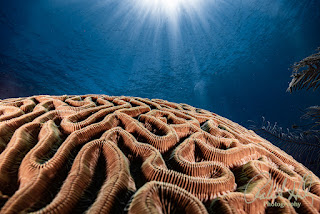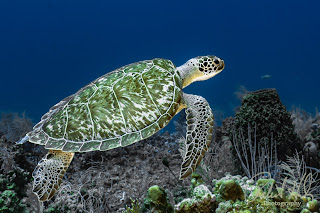Creating Custom AI-Powered Color Profiles for Different Depths in Lightroom (Update)
With the recent advancements made in Adobe Lightroom, I needed to update my previous blog post on this subject and align it with the new tips, tricks, and tools available.
Underwater photographers are acutely aware that the ocean is a dynamic environment that transforms not only with the ebb and flow of the tides but also significantly with varying depths. At a mere 10 feet underwater, a photo might appear vibrant and color-balanced. Yet, as you descend to 60 feet, these colors can shift dramatically, taking on green, gray, or blue hues due to changes in the water's optical properties. The once vivid reds and yellows stand out in shallower waters and can quickly fade away, often disappearing almost instantaneously - faster than one can utter "neutral buoyancy.”
To address these challenges and empower photographers, this updated guide provides an in-depth look at leveraging Adobe Lightroom Classic’s advanced AI-powered tools. These tools enable photographers to create tailored color profiles corresponding to specific dive depths. By utilizing these profiles, underwater photographers can ensure their images remain consistent, accurate, and visually stunning, regardless of how deep into the ocean they venture, preserving the captivating beauty of the underwater world.
Table of Contents
- Why You Need Depth-Based Color Profiles
- Step-by-Step: Creating Custom AI Color Profiles
- Sample Use Cases
- Final Tips for Accuracy at Depth
- Closing Thoughts
Why You Need Depth-Based Color Profiles
Water acts as a color thief, absorbing hues as one descends into its depths. The phenomenon begins with the vibrant red tones, which disappear first, followed closely by the warmer oranges, bright yellows, and serene greens. Finally, even the tranquil blues fall victim to the water's light-absorbing properties. This inherent challenge in underwater photography has long been frustrating for photographers trying to capture the true essence of their subjects. However, with technological advancements, we now have an innovative solution. Photographers can create sophisticated, AI-powered color profiles using Lightroom’s AI Adaptive Presets, AI Masking, and Calibration tools. These tools intelligently adapt to and compensate for depth-specific lighting loss, allowing for vibrant and true-to-life color representation in underwater imagery. As a result, rather than struggling against the natural loss of color, we can enhance our photos to reflect the brilliant colors beneath the water's surface.
Step-by-Step: Creating Custom AI Color Profiles for Different Depths
Here’s how I create custom profiles based on typical dive depth zones:
- 0–15 feet (Shallow Reefs / Snorkel Zone)
- 15–40 feet (Typical Recreational Range)
- 40–80 feet (Advanced Recreational)
- 80–120+ feet (Technical Dives)
1. Start with a Clean Image
When selecting images for each specified depth range, it is essential to choose representative visuals that accurately reflect the environment and characteristics of those particular depths. Begin by meticulously picking an image that embodies or represents the unique features of the specific depth category. After selecting an image, press the appropriate button or tool to verify the metadata associated with that image, if available. This metadata can provide valuable context about the image, such as the location, time of capture, and other relevant details that enhance the understanding of the image's significance. Additionally, aim to choose photographs that prominently feature warm colors, especially shades of red and orange, as well as neutral tones like sand or white coral. These colors not only add visual appeal but can also serve to highlight the natural beauty and diversity found within the various depth ranges. By following these guidelines, you can ensure that the selected images are both representative and visually engaging for the intended purpose.
2. Correct White Balance Using AI Masks
Press M to open the Masking panel. Use “Select Subject” and “Select Background.” Press Shift + W to quickly access the White Balance Tool.
- Adjust Temp to restore warmth.
- Adjust Tint to reduce magenta or green cast
- Brighten the subject slightly and lower the saturation on the background
3. Use the Calibration Panel
Scroll to the bottom of the Develop module and adjust:
- Red Primary Hue for tonal correction
- Red Primary Saturation to restore vibrancy
- Blue Primary Hue/Sat for shadow balance
Example Settings:
- 15–40 ft: Red Hue -10, Sat +30
- 40–80 ft: Red Hue -20, Sat +40, Blue Hue +10
- 80–120 ft: Red Hue -35, Sat +50, Blue Sat -10
4. Save as an Adaptive AI Preset
Click + in the Presets panel - Create Preset
- Check “Adaptive: Subject” and “Adaptive: Background”
- Name it: Color Restore - 15-40ft AI
- Click Create
5. Use the Tone Curve
Press Ctrl + 2 (Windows) or Cmd + 2 (Mac) to open the Tone Curve. Create a soft S-curve and adjust the Red Channel slightly upward for warmth.
6. Sync Settings Across Dive Shots
Select your adjusted image + others from the same dive. Click Sync… or press Ctrl + Shift + S. Check only relevant settings (WB, Calibration, Tone Curve, Masks).
7. Fine-Tune in the HSL Panel
Press Ctrl + 3 to open HSL. Suggestions:
- Push Oranges/Reds Hue toward red
- Increase Saturation of Reds
- Reduce Aqua Luminance to darken the water
Sample Use Cases
| Depth | Subject | Adjustments |
|---|---|---|
| 10 ft | Anemonefish | Minimal – warm WB, slight red saturation |
| 35 ft | Spotted Drum | AI Subject Mask + mid-red hue push |
| 60 ft | Seahorse | Full AI masking + Calibration + warm-up |
| 90 ft | Lionfish | Intense red calibration, shadow lift, AI subject selection |
| 115 ft | Wreck with diver | Significant blue desaturation, red channel warmth, isolated diver |
Final Tips for Accuracy at Depth
- Shoot in RAW for full-color recovery
- Use custom white balance in-camera when possible
- Log dive depths to apply presets accurately later
- Update your presets regularly as Adobe AI evolves
Closing Thoughts
With its vast and ever-changing hues, the ocean may seem to absorb or dull our colors, making the world appear less vibrant and lively. However, with the powerful capabilities of Lightroom, we can reclaim and enhance those lost colors with remarkable precision and detail. By utilizing depth-specific adaptive profiles within this software, you will achieve stunning color consistency across your images and significantly reduce the time spent on post-processing. This means you can focus more on your creative vision while trusting that your pictures will maintain their true vibrancy and depth, allowing you to produce striking visuals quickly and efficiently.
Until next time — keep diving, shooting, and editing your way to WOW.
- 💡 Read more Lightroom tips and stay informed when new blog posts are published weekly at RobertHerb.blogspot.com.
- 💡 Join my upcoming online training program – Learn to enhance your underwater shots with Adobe Lightroom! Sign up for a FREE "Before & After" Gallery.
- 💡 Share your processed photos on social media using #RobertHerbPhotography.
- 💡 Have questions? Email me at bob@robertherb.com.
Written by Robert Herb – Empowering underwater photographers to capture and enhance the beauty of our oceans.
Stay tuned for more in-depth insights into underwater photography. Let’s dive deeper into the art and craft of capturing the marine world! If you have any comments or suggestions, I’d love to hear them.
Get ready for an exciting underwater photography adventure! For more details on my upcoming online training course, check out my "Training" page at RobertHerb.com or email me at bob@robertherb.com.
Sincerely,
Bob Herb
|
|





Comments
Post a Comment
Please let me know your comments.